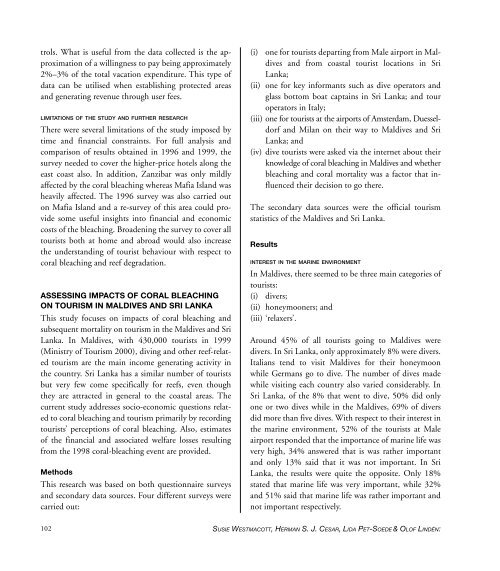Create successful ePaper yourself
Turn your PDF publications into a flip-book with our unique Google optimized e-Paper software.
trols. What is useful from the data collected is the approximation<br />
<strong>of</strong> a willingness to pay being approximately<br />
2%–3% <strong>of</strong> the total vacation expenditure. This type <strong>of</strong><br />
data can be utilised when establishing protected areas<br />
and generating revenue through user fees.<br />
LIMITATIONS OF THE STUDY AND FURTHER RESEARCH<br />
There were several limitations <strong>of</strong> the study imposed by<br />
time and financial constraints. For full analysis and<br />
comparison <strong>of</strong> results obtained in 1996 and 1999, the<br />
survey needed to cover the higher-price hotels along the<br />
east coast also. In addition, Zanzibar was only mildly<br />
affected by the coral bleaching whereas Mafia Island was<br />
heavily affected. The 1996 survey was also carried out<br />
on Mafia Island and a re-survey <strong>of</strong> this area could provide<br />
some useful insights into financial and economic<br />
costs <strong>of</strong> the bleaching. Broadening the survey to cover all<br />
tourists both at home and abroad would also increase<br />
the understanding <strong>of</strong> tourist behaviour with respect to<br />
coral bleaching and reef degradation.<br />
ASSESSING IMPACTS OF CORAL BLEACHING<br />
ON TOURISM IN MALDIVES AND SRI LANKA<br />
This study focuses on impacts <strong>of</strong> coral bleaching and<br />
subsequent mortality on tourism in the Maldives and Sri<br />
Lanka. In Maldives, with 430,000 tourists in 1999<br />
(Ministry <strong>of</strong> Tourism 2000), diving and other reef-related<br />
tourism are the main income generating activity in<br />
the country. Sri Lanka has a similar number <strong>of</strong> tourists<br />
but very few come specifically for reefs, even though<br />
they are attracted in general to the coastal areas. The<br />
current study addresses socio-economic questions related<br />
to coral bleaching and tourism primarily by recording<br />
tourists’ perceptions <strong>of</strong> coral bleaching. Also, estimates<br />
<strong>of</strong> the financial and associated welfare losses resulting<br />
from the 1998 coral-bleaching event are provided.<br />
Methods<br />
This research was based on both questionnaire surveys<br />
and secondary data sources. Four different surveys were<br />
carried out:<br />
(i) one for tourists departing from Male airport in Maldives<br />
and from coastal tourist locations in Sri<br />
Lanka;<br />
(ii) one for key informants such as dive operators and<br />
glass bottom boat captains in Sri Lanka; and tour<br />
operators in Italy;<br />
(iii) one for tourists at the airports <strong>of</strong> Amsterdam, Duesseldorf<br />
and Milan on their way to Maldives and Sri<br />
Lanka; and<br />
(iv) dive tourists were asked via the internet about their<br />
knowledge <strong>of</strong> coral bleaching in Maldives and whether<br />
bleaching and coral mortality was a factor that influenced<br />
their decision to go there.<br />
The secondary data sources were the <strong>of</strong>ficial tourism<br />
statistics <strong>of</strong> the Maldives and Sri Lanka.<br />
Results<br />
INTEREST IN THE MARINE ENVIRONMENT<br />
In Maldives, there seemed to be three main categories <strong>of</strong><br />
tourists:<br />
(i) divers;<br />
(ii) honeymooners; and<br />
(iii) ‘relaxers’.<br />
Around 45% <strong>of</strong> all tourists going to Maldives were<br />
divers. In Sri Lanka, only approximately 8% were divers.<br />
Italians tend to visit Maldives for their honeymoon<br />
while Germans go to dive. The number <strong>of</strong> dives made<br />
while visiting each country also varied considerably. In<br />
Sri Lanka, <strong>of</strong> the 8% that went to dive, 50% did only<br />
one or two dives while in the Maldives, 69% <strong>of</strong> divers<br />
did more than five dives. With respect to their interest in<br />
the marine environment, 52% <strong>of</strong> the tourists at Male<br />
airport responded that the importance <strong>of</strong> marine life was<br />
very high, 34% answered that is was rather important<br />
and only 13% said that it was not important. In Sri<br />
Lanka, the results were quite the opposite. Only 18%<br />
stated that marine life was very important, while 32%<br />
and 51% said that marine life was rather important and<br />
not important respectively.<br />
102 SUSIE WESTMACOTT, HERMAN S. J. CESAR, LIDA PET-SOEDE & OLOF LINDÉN:


















